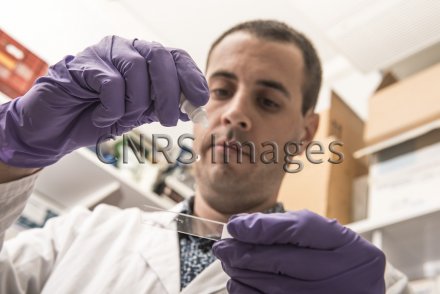Production year
2017

© Hubert RAGUET / Institut Cochin / CNRS Images
20170080_0004
Treatment of tissue from seropositive patients undergoing triple therapy with a view to identifying the reservoir cells, in which the virus multiplies very slowly. These tissues, taken from the genital organs (penis) of seropositive patients undergoing effective treatment, or healthy subjects, are fixed then encapsulated in a resin. In order to detect the genetic material of the virus (RNA), the tissues are then cut into thin slices (4-5 microns) before being deposited on glass slides. To reveal the RNA, the tissues on the slides undergo several treatments (ethanol and oxygenated water baths and heating to 40°C, among others). They are then treated with specific viral RNA probes using new, highly sensitive RNAscope technology. Reservoir cells are infected cells in which the virus, for reasons that are still poorly understood, becomes dormant, or replicates very slowly. This means that the virus is invisible from outside the cell, and therefore escapes the immune response and antiretroviral treatments. If treatment is stopped, the virus starts to multiply again in large numbers, and the disease progresses once again. The most studied reservoir is located in the CD4+ T lymphocytes in the blood. However, although there are many signs that other reservoirs exist in tissues, very little is known about the nature and dynamics of these tissue reservoirs, notably in terms of macrophages. The "Mucosal entry of HIV and mucosal immunity" team led by Morgane Bomsel is in the process of characterising these viral reservoirs at the level of tissue macrophages. The characterisation of these new reservoirs is vital for the development of an effective strategy for HIV eradication.
The use of media visible on the CNRS Images Platform can be granted on request. Any reproduction or representation is forbidden without prior authorization from CNRS Images (except for resources under Creative Commons license).
No modification of an image may be made without the prior consent of CNRS Images.
No use of an image for advertising purposes or distribution to a third party may be made without the prior agreement of CNRS Images.
For more information, please consult our general conditions
2017
Our work is guided by the way scientists question the world around them and we translate their research into images to help people to understand the world better and to awaken their curiosity and wonderment.